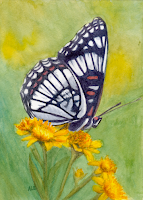The Weidemeyer's Admiral Butterfly Limenitis weidemeyerii, was painted from a photograph I took at Grand Teton National Park, while on a Naturalist led Butterfly walk at the top of Signal Mountain. The summit provides panoramic views of the Teton Range, Jackson Hole valley and Jackson Lake. During our walk we saw several butterflies, but none as spectacular as this western species. This family of butterflies first pair of legs are so small they resemble little brushes, which gives them their common name 'brushfooted'. Other members of the family Nyphalidae include: the Monarch, Red Admiral, Blue Morpho and Painted Lady.
The first landscape features the amazing Firehole Spring, one of the most colorful pools along Firehole Lake Drive, Yellowstone National Park. The spring bubbles and steams but is not a geyser. The clear turquoise blue water is the hottest part of the spring, so hot that even thermophiles can not live in there. They prefer the run offs where the water is cooler. Yellow or green mats of thermophiles are found closer to the springs in higher temperatures (up to 167º F). Lower temperature areas have mats of orange, rust and brown. In addition to temperature, springs and geysers can be acidic, neutral, or alkaline. The Ph also determines what bacteria can live there. One part of the painting that is not very visible at this small size are the white siliceous collars where the water touched the nearby standing dead Lodgepole pines.
After the storm, the second landscape, is of a Yellowstone geyser field lit by sun rays bursting through holes in the clouds as the storm is slowly breaking up. The steam of the geysers are in sharp relief, between the shadowed trees in the foreground and the dark green distant hills.



No comments:
Post a Comment